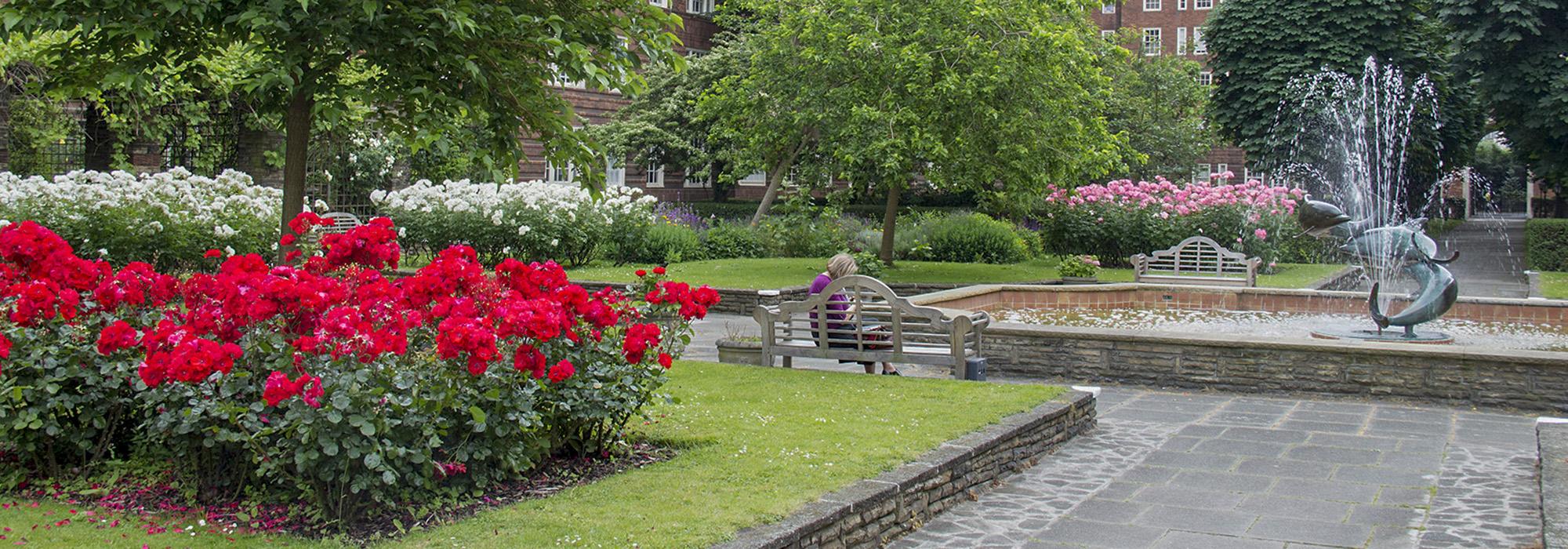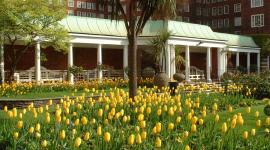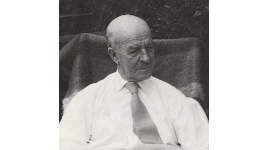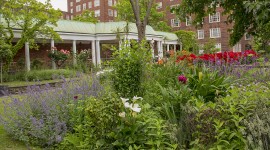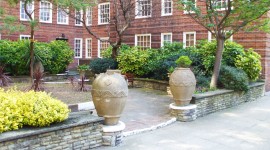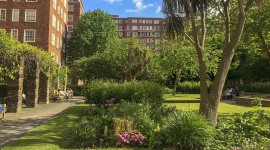London’s Dolphin Square Gardens Faces Threat
Located beside the River Thames in the Pimlico area of Central London, Dolphin Square Gardens represents one of the few surviving designs by noted author, horticulturist, and landscape architect Richard Sudell. Although it has been recently included on the Historic England Register of Parks and Gardens, the landscape may yet be destroyed by renovations to the apartment block that surrounds it.
History
The site that would become Dolphin Square was first developed in 1820 by Thomas Cubitt, who built workshops there to support construction in Pimlico and the adjacent Belgravia neighborhood. The American developer Fred French purchased the seven-acre site from the Duke of Westminster in 1934, planning to build a ten-story apartment block called Ormonde Court. But when financing for the project fell through, the parcel was sold to the U.K. construction firm Richard Costain & Sons Ltd., in 1935, with architect Gordon Jeeves chosen to design an apartment complex. Jeeves altered much of the original plan for Ormonde Court but retained the concept of a single, rectangular apartment block enclosing a large, central landscape. Renamed Dolphin Square, the ten-story, brick-faced complex comprises more than 1,200 apartments and was designed as a self-contained living environment, a city within a city originally including shops, leisure facilities, dining amenities, a telephone exchange, a car park, and a gas station. The building forms the perimeter of a 2.5-acre courtyard designed by the influential landscape architect Richard Sudell in 1936 and completed in 1938.
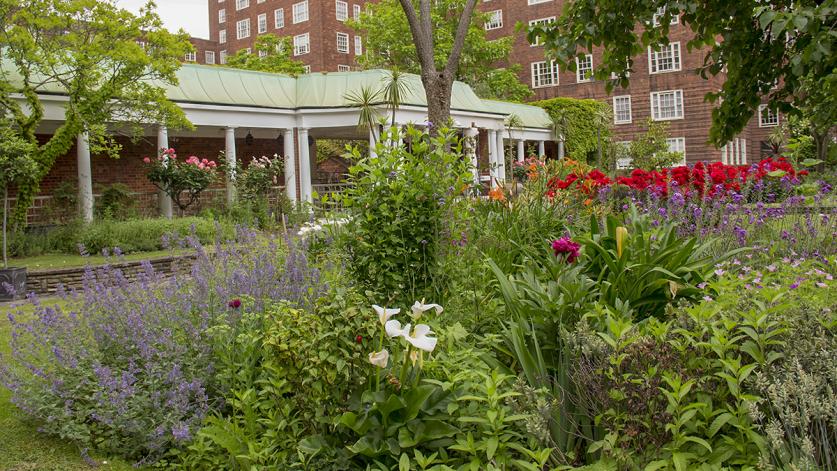
Much of Sudell’s expansive courtyard is technically a roof garden, having been constructed atop a basement garage, with a second elevated roof garden over a sports complex (and possibly the first major residential roof garden designed in London). The courtyard is entered from Grosvenor Road, to the south, via three arches, while two vaulted passages give access from Chichester Street on the north. The courtyard comprises three primary landscapes, each formally designed with a different character and function and arranged in sequence along a central north-south axis. At the south, a large, open lawn is framed by a privet hedge and evenly divided by a wide, axial pathway lined with horse chestnuts. The pathway leads north, passing through the hedge into the Fountain Garden (also known as the rose gardens), the second formal space in the sequence, which contains four raised lawns and rose beds outlined by paving and disposed around a central fountain with notched corners. This gives way, farther north, to a raised loggia fronted by Doric columns. Within the loggia, a flight of stairs leads to the Spanish Garden atop the roof of the complex’s spa and gymnasium. Redesigned circa 2000, the Spanish Garden covers 100 square meters and is paved in terra cotta, with pergolas and trellises symmetrically disposed along both sides, and the original lion’s head fountain at the center of the north side.
Along the eastern and western perimeter of the interior courtyard are five pairs of bays formed by the projecting spurs of the building. The central pair of bays contain pergolas and seating, with screens designed to hide the car park vents; the others contain ornamental gardens, namely an Italian, Japanese, Dutch, and Old English sunken garden. Sudell was a capable horticulturist, and his plantings throughout the courtyard were designed to blossom as the seasons progressed. A variety of paving patterns and styles are used throughout the courtyard, designed to enhance the distinctiveness of each garden area, with one arrangement unobtrusively transitioning into another. A variety of large, ornamental concrete pots are placed atop plinths, in walled recesses, and on steps throughout, announcing entrances and further defining spaces.

A noted writer, horticulturist, and landscape architect, Richard Sudell (1892 – 1968) played a crucial role in founding the Institute of Landscape Architects in 1929 (ILA, since renamed the Landscape Institute), serving as its president from 1955 to 1957. Notably, he partnered with Marjory Allen (Lady Allen of Hurtwood) in the design of the roof garden of Selfridges Department Store on London’s Oxford Street, which was destroyed by enemy action during World War II. Prior to his work on Dolphin Square, Sudell designed the gardens and landscape for the Modernist headquarters of the de Havilland Aviation Company at Hatfield in 1934. He designed the memorial garden at the City of London cemetery and crematorium in the 1950s, as well as various sports fields, grounds of private estates, and other projects. Although overshadowed by others associated with the ILA, such as Thomas Mawson, Thomas Adams, Edward White, and Geoffrey Jellicoe, Sudell was a prolific author of practical books covering all aspects of garden and landscape design, including Landscape Gardening, published in 1933 and aimed at a popular audience. He urged the development of gardens and landscapes for factories, hotels, on roofs, for airports, and as part of new estates. From 1934 to 1939 Sudell edited the ILA’s journal Landscape and Garden. He also served as the editor of the garden section of the Daily Herald newspaper and contributed to many other publications.
Within three years of completion, the buildings and gardens of Dolphin Square sustained wartime bombing; approximately seventeen high-explosive bombs fell on or close to the site, with at least one direct hit to the Fountain Garden and another to one of the blocks adjacent to the south lawn. Information about the extent of damage or the repairs effected is scant. Costain continued to manage the complex until 1959, and the damaged parts of the garden were likely restored to the original design, subject to the availability of materials. Unfortunately, there are no surviving plans of Sudell’s design, only contemporary photos and written accounts.
Threat
The Dolphin Square Gardens represent one of the few intact, large-scale landscapes designed for private housing projects in London during the interwar period. The site is also one of a limited number of designs known to survive by Richard Sudell, an important and influential figure in the development of mid-twentieth-century landscape architecture in the United Kingdom, and a pioneering theorist, writer, and advocate for his profession. Notwithstanding the reconfiguration of the Spanish Garden (which nevertheless “retains its essential character”), the overall structure and layout of the Dolphin Square landscape maintains a high degree of integrity. Moreover, the complex lies within the Dolphin Square Conservation Area, and the landscape was listed as Grade II on the Historic England Register of Parks and Gardens in June 2018, indicating that it is of “special interest” as an historic resource.
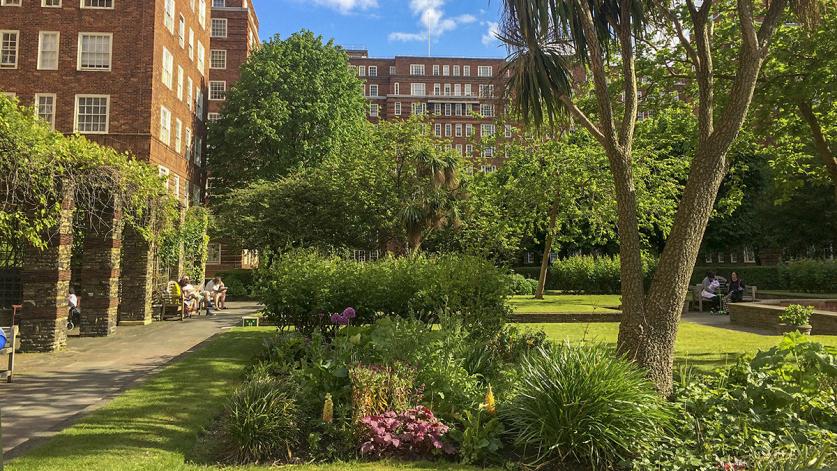
Even so, the Planning Department of the Westminster City Council (WCC) is now poised to decide the fate of the Dolphin Square Gardens, as major changes are being proposed to the site by the U.S.-based Westbrook Partners, which now owns the property. These changes include the demolition and rebuilding of the northern end block, with additional floors to be added, as well as a new basement, two levels deep, that would extend into the interior courtyard. Under these plans, the northern portion of the courtyard would be demolished, including the Fountain Garden and the rooftop Spanish Garden accessed via the loggia. The proposed work would take place over an estimated five years and would prompt a redesign of nearly the entire landscape apart from the lawn and the avenue of horse chestnuts. The plans have been before the WCC since February 2018, and no date has been given for a final decision.
These sweeping changes aside, it is also apparent that the landscape is beginning to fall prey to deferred maintenance and uninformed stewardship. Several of the large, decorative pots are now cracking, and incompatible materials have been introduced to the gardens, as paving is replaced with tarmac and slate is used as an alternative to planting materials, many of which are smothered in ivy.
What You Can Do to Help
Sign an online petition to save the Dolphin Square Gardens. The petition will be presented to the WCC in advance of its decision and may influence the outcome.
Formal written objections can also be addressed to the case officer, Ms. Julia Asghar, Development Planning Services, Westminster City Hall, Victoria Street, London, SW1E.



